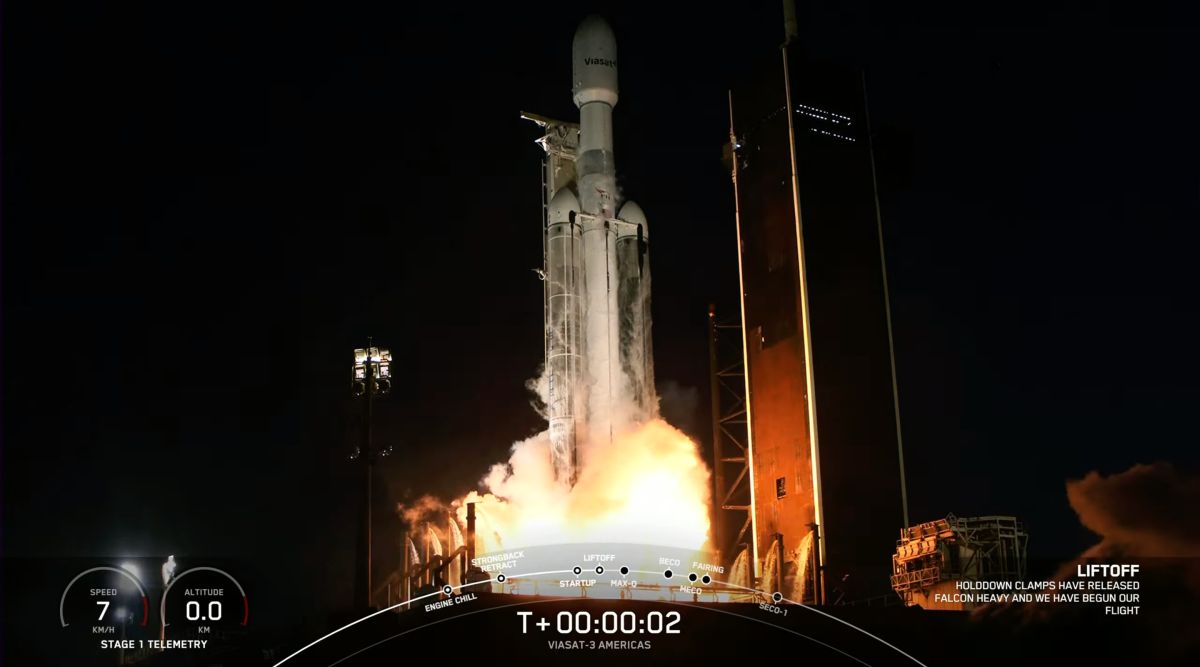SpaceX’s giant Falcon Heavy rocket has flown into space for the sixth time. Its launch was successful, although the side boosters did not have this opportunity to land gently. The carrier successfully launched three large satellites into geostationary orbit.

Superheavy rocket successfully launched
SpaceX successfully launched its Falcon Heavy superheavy rocket. It put three satellites into geostationary orbit. With this, the employees of Elon Musk slightly smoothed out the unpleasant experience from the not very successful test of an even larger Starship rocket, which happened almost two weeks ago.
This time, the carrier successfully launched three satellites into a geostationary orbit with a height of 35,700 km. They were planned to launch them on April 28, but it was possible only at 2.26 a.m. on May 1, GMT+3. For another 4.5 hours, the specialists had to wait until all the spacecraft separated from the carrier.
Which satellites did Falcon Heavy put into orbit
The main load in this mission was the ViaSat-3 Americas communications satellite, owned by the Viasat satellite communications operator. Its weight is as much as 6.4 tons. It is expected that it will become a spacecraft with a higher throughput in geostationary orbit.
The second was also a communication spacecraft called Arcturus. It is expected that it will be managed by Astranis Space Technologies from San Francisco. Although this satellite is much smaller than the Viasat satellite and weighs 300 kg, it will still be a powerful repeater and will provide Alaska and neighboring regions with Internet speeds of up to 7.5 Gbit/s.
The third spacecraft will be a very small GS-1 cubesat, which will be managed by Gravity Space from Washington. Its main purpose will be to provide communication for the needs of the “Internet of things”, that is, electronic devices that exchange data packets electronically, although it will have several additional features.
The spacecraft is also designed to provide orbital slot reservation services (BIU) around the geosynchronous arc. The spacecraft features three wideband frequency bands. “The spacecraft will also carry an imaging system capable of imaging both the Earth and spatial bodies, as well as an experimental rendezvous and docking payload.”
The sixth launch of the Falcon Heavy
The Falcon Heavy rocket made its first flight in 2018. Then Elon Musk launched his old Tesla car into space for a demonstration. From then until the autumn of 2022, the Falcon Heavy remained the heaviest rocket successfully used today.
In the autumn of 2022, it lost this title to the Space Launch System (SLS), however, in the spring SpaceX expected to regain leadership with Starship, it launched, but it never reached orbit. But taking into account the fact that the SLS will not leave soon, the Falcon Heavy remains the largest rocket that flies into space regularly.
However, the concept of “regularly” relative to it is rather conditional. This launch was only the sixth for it. At the same time, the previous one took place in January, when Falcon Heavy carried out a mission for the US Department of Defense, and two more took place in 2022.
According to www.space.com
Follow us on Twitter to get the most interesting space news in time
https://twitter.com/ust_magazine

